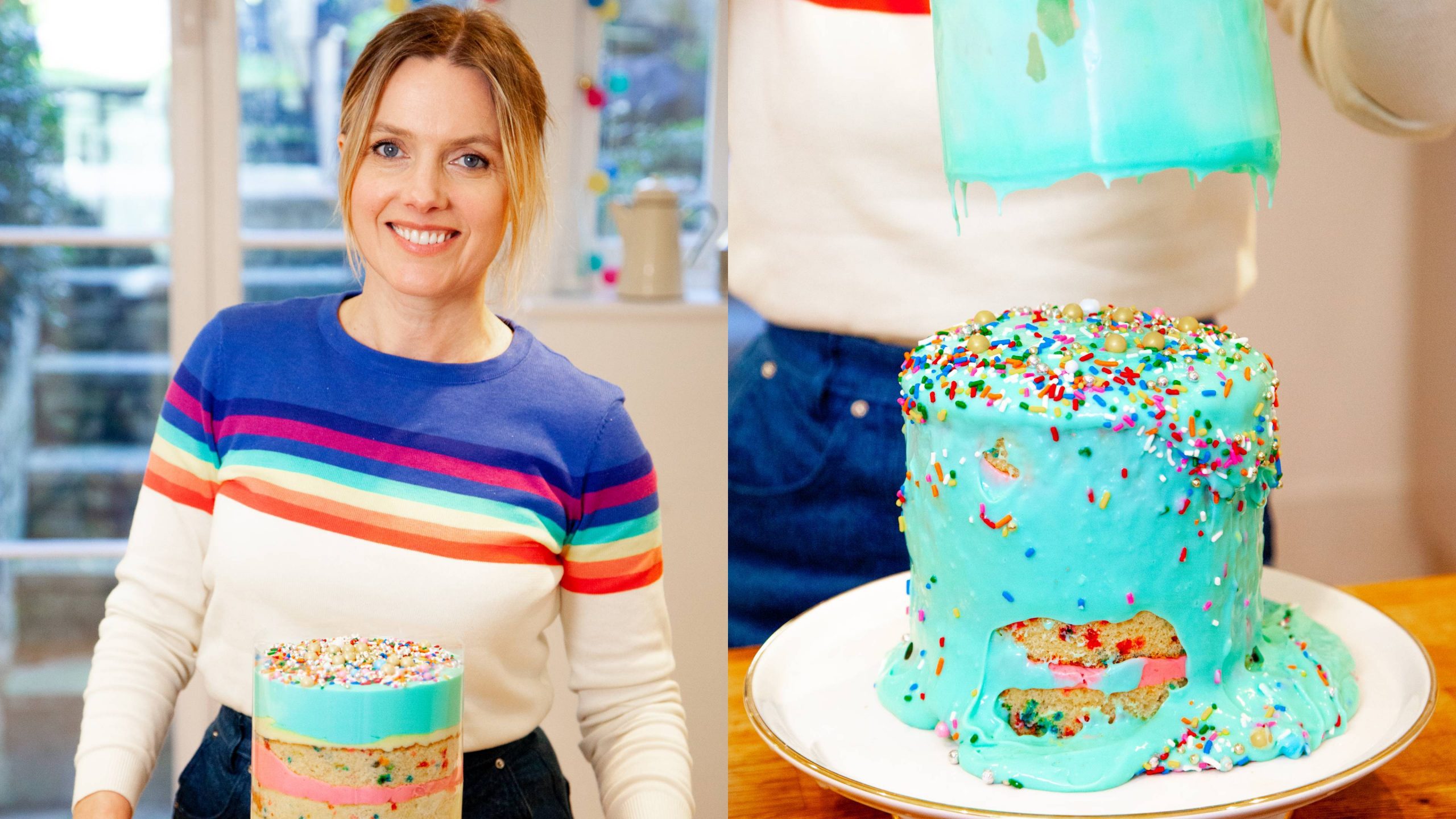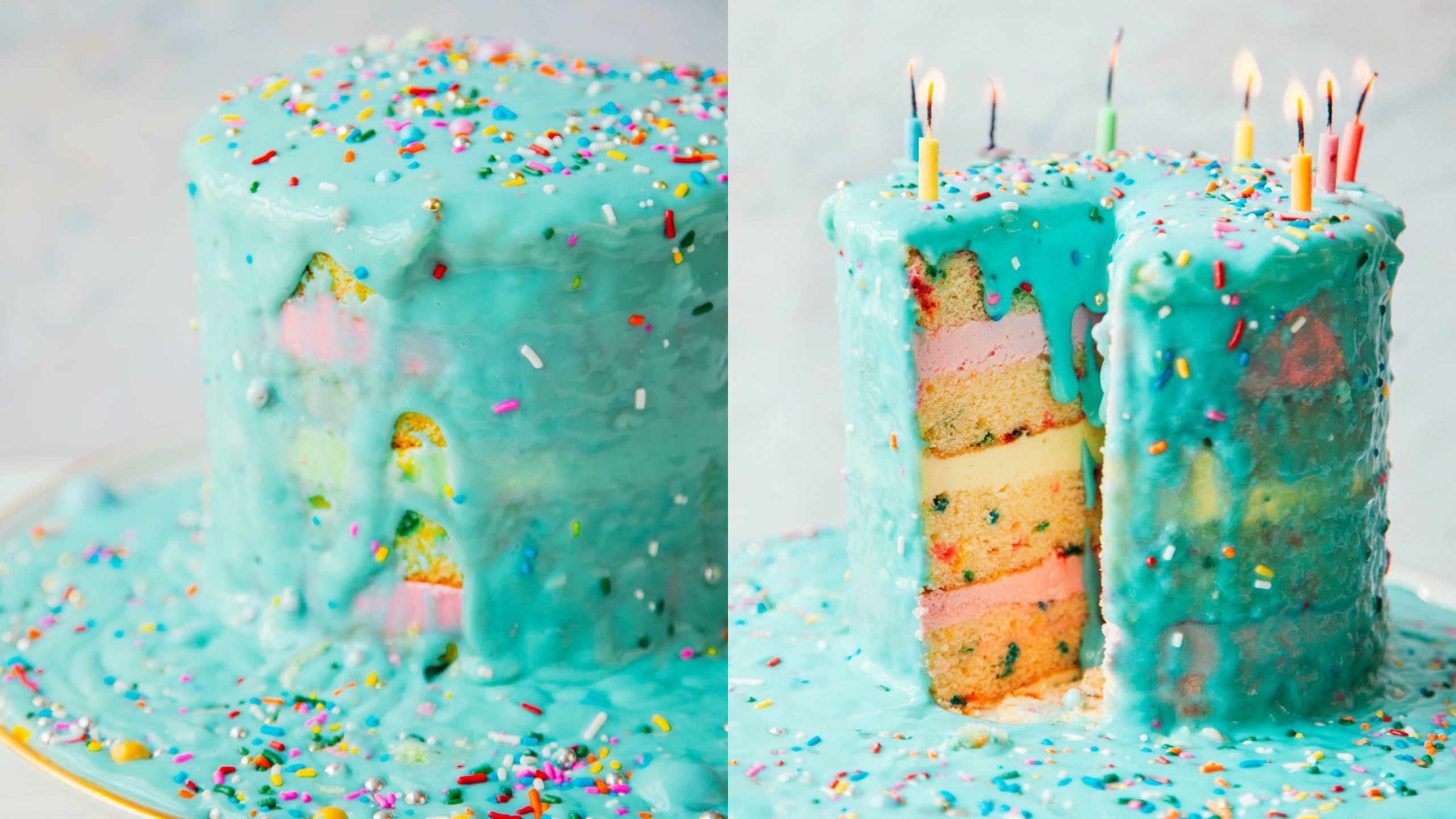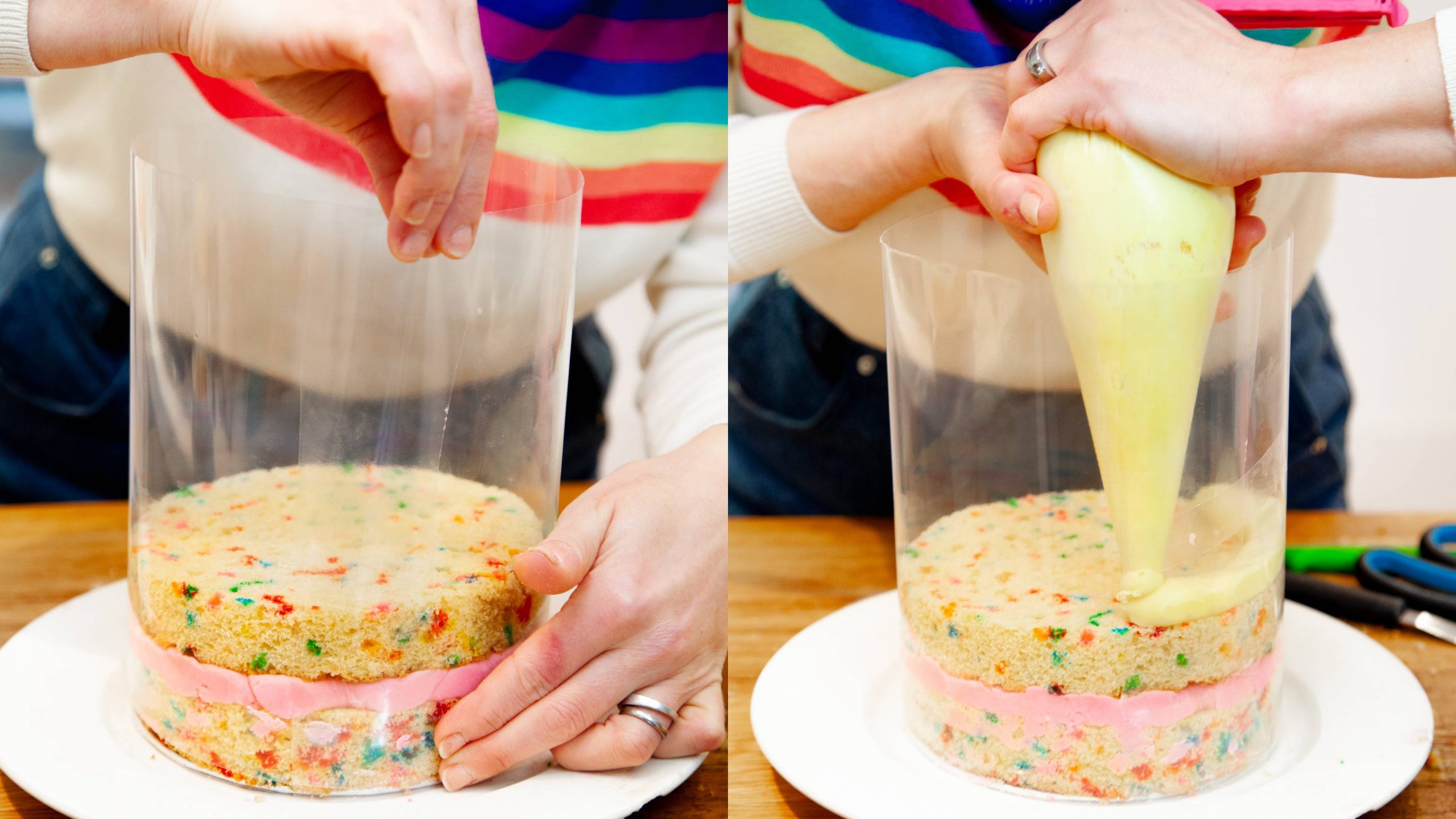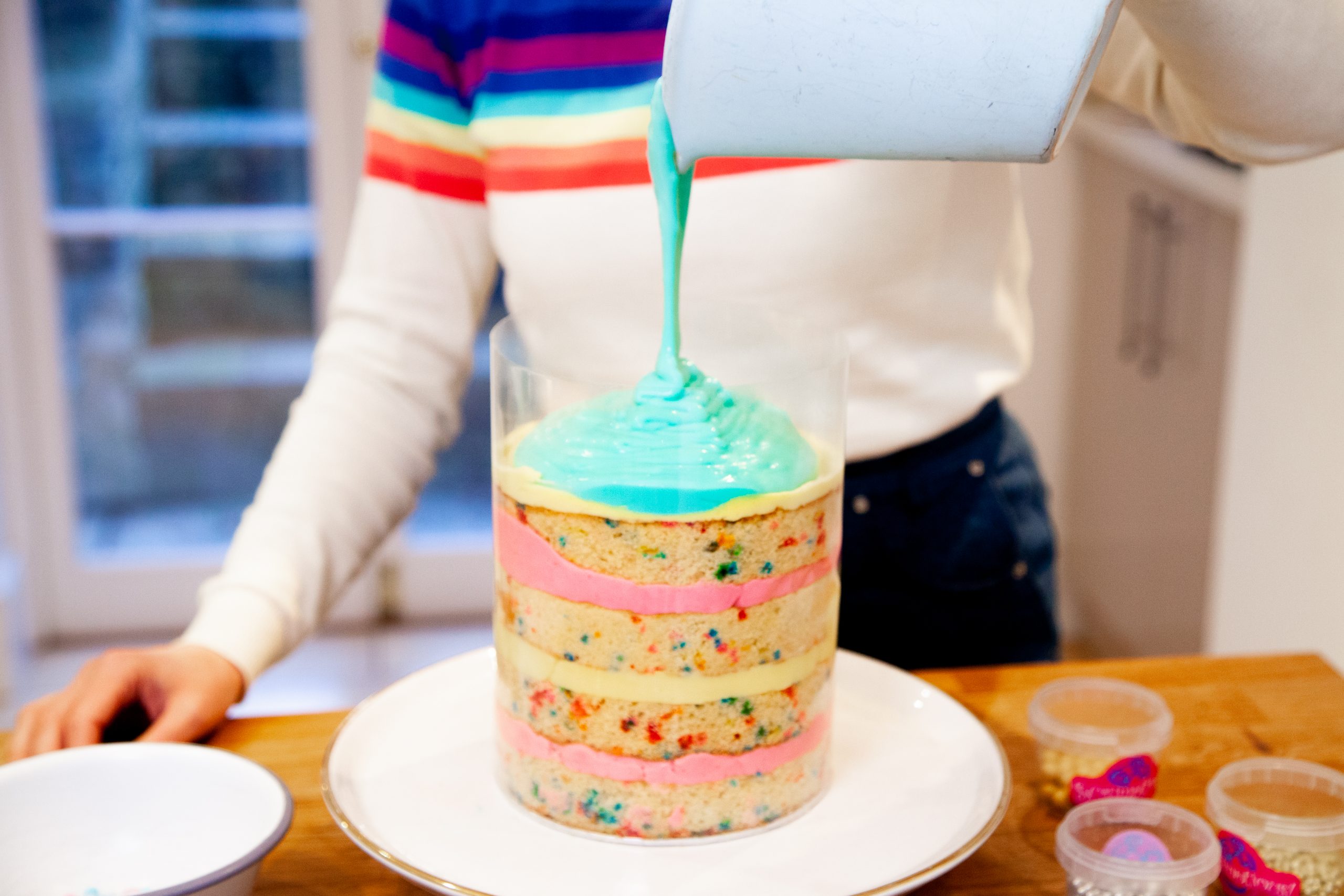How to make a tsunami cake
Impress your friends and family with this showstopping tsunami cake. Follow celeb chef Juliet Sear's step-by-step method...


Follow Juliet Sear's step-by-step guide on how to make a tsunami cake. From funfetti sponge to double cream icing, discover everything you need to know about making a tsunami cake.
We’ve teamed up with baking expert and best-selling cookbook author Juliet Sear to create the latest food trend - a tsunami cake. It's called a tsunami cake, as the icing is held in place at the top of the cake with acetate, wrapped around the outside of the cake. The idea is to carefully and slowly lift the acetate up, allowing the icing to cascade in a 'tsunami effect' down the sides of the cake.
Also known as a ‘pull-me-up cake’, a tsunami cake is the latest showstopping cake trend to go viral. If you like a baking challenge and have already tried making a drip cake, cleverly hidden shape cupcakes, or a layered rainbow cake, you may want to add this masterpiece to your list.
In our exclusive video, Juliet talks you through each step of the process - and we've also outlined the method below. Juliet, who is also a regular on ITV's This Morning, says, “The great thing about a tsunami cake is that it bring theatre to the table. It’s all about movement.”
Watch our step-by-step video on how to make a tsunami cake
In this article, we look at the following stages of making a tsunami cake:
Do you need special equipment to make a tsunami cake? How to make a tsunami cake The tsunami cake sponge How to make the buttercream frosting Assembling the tsunami cake Tsunami cake icing How to reveal a tsunami cake Storing leftover tsunami cake
Do you need special equipment to make a tsunami cake?

The most important piece of equipment needed to make a tsunami cake is acetate. Juliet says; “The idea is that you build your cake wrapped in the acetate, as shown above. You wrap the sponge tightly so that you can pour the icing on and then you just lift it up which allows the icing to flow all at once.”
Parenting advice, hot topics, best buys and family finance tips delivered straight to your inbox.
Juliet uses a 20cm high acetate but says, “If you can’t find the tall ones, you can just sellotape two pieces of acetate together so if you want to make something really nice and tall.”
To make a tsunami cake Juliet has used the following:
- A medium crank handle palette knife for frosting
- Piping bags
- Cake leveler or large bread knife - we recommend Tala cake leveler
- 6” round thin cake card to cut around and use as a base
- Large lipped cake plate or stand
- Acetate to wrap around the cake, 20cm high - we recommend Cake Collars, available in different sizes
- 7” round cake tin/s
- Sellotape
- Scissors
- Baking parchment
How to make a tsunami cake
Before you start making your tsunami cake make sure you have everything you need out in front of you. It's best to create this cake in stages. Start with the sponges first. Leave them to cool completely and then you can move onto the buttercream. Once the buttercream is ready and in piping bags, you can move onto making the tsunami cake frosting and assembling.
Begin by preheating the oven to 180 degrees fan. You will also need to grease, base, and sideline 4 x 7” round cake tins (or do in batches if you do not have multiple tins)

Step one: How to make the tsunami cake sponge
Juliet has used her funfetti sponge recipe for the cake, with added sprinkles. This is perfect if you're choosing to make this cake for a special occasion, and adds an extra 'wow' factor when it comes to cutting. You could make this with readymade, shop-bought sponges instead if you're short of time - and you could also experiment with different flavours too, like a chocolate sponge cake base, lemon drizzle, or even a marble cake.
Ingredients for the tsunami cake sponge:
- 400g soft salted butter, at room temp
- 2 tsp vanilla bean paste or extract
- 400g caster sugar
- 8 medium free-range eggs
- 400g self-raising flour with 1 tsp baking powder whisked into it
- 4 tablespoons bright bake stable cake sprinkles
Method for the tsunami cake sponge:
1. In a stand mixer bowl with a paddle beater attachment or a large bowl using a hand whisk, beat the butter, vanilla, and sugar on fast speed until really light, pale, and creamy. Stop the mixer and scrape the bowl down as needed throughout.
2. Add the eggs, one at a time, and beat until combined at a slow speed. Add the flour and baking powder in increments of 3, beating very slowly until only just mixed.
3. Throw in the sprinkles and mix through gently
4. Divide the batter equally into the tins and bake for around 20-25 minutes until the sponges are springy, lightly golden, and cooked in the centre completely.
5. Leave to cool in the tin for 5 minutes, then turn out onto a cooling rack, remove the paper and allow to cool. While the cakes are cooling make your frosting.
Step two: How to make the buttercream frosting

For the buttercream, Juliet Sear has chosen a sweet strawberry buttercream, which is made using strawberry jam and flavouring. She has also used a subtle vanilla buttercream too, which creates an impressive finish to your cake once cut. The buttercream sandwiches the cake layers together firmly. Once the buttercream is set it should keep the cake steady, so it will remain in place once the acetate is removed.
"I’ve put the buttercream into a piping bag as it makes it easier to get into the acetate as the acetate is quite tall. And you’ll get a much neater finish," says Juliet. "I've gone for a 1cm thick layer of buttercream so you can really see the defined layers."
Ingredients for the buttercream frosting:
- 300g soft unsalted butter
- 2 tsp vanilla bean paste
- 900g superfine icing sugar, sifted
- 2 tablespoons strawberry jam, sieved
- 2 tsp strawberry flavouring
- Yellow and pink food colouring
Method for the buttercream frosting:
1. Place the butter and vanilla in your stand mixer bowl with the paddle beater or use a bowl with a hand whisk and beat on high until very creamy and smooth, for a minute or so
2. Gradually add the icing sugar, about a quarter at a time, beating each addition on slow first so the icing sugar doesn’t puff up everywhere, once combined turn to high speed for a minute or so each time. Juliet says; "A good tip to ensure your buttercream is creamy and fluffy - add a tablespoon of recently boiled water into the bowl with each addition of the sugar, mix it on slow then turn up to high."
3. Take 400g of the frosting and tint it a light yellow colour and place it in a large piping bag
4. With the remaining frosting, add in the jam, flavouring, and colouring and beat through, place into your piping bags.
Step three: How to assemble a tsunami cake

The main thing to keep in mind when assembling a tsunami cake is that the edges of the sponge cake and the edges of the buttercream touch the acetate completely all the way around the cake. This will form a barrier to stop any of the tsunami icing seeping through the cake or down the sides when you don't want it to.
Pressing the sponges down firmly when assembling and putting the cake in the fridge to cool will also help to prevent this from happening as Juliet discusses below.
Method for assembling a tsunami cake:
1. Level off any uneven humps from the top of each cake to make flat with a cake leveler or bread knife. Cut a round 6” disc from each cake to trim off the crust so that the cake sprinkles can be seen in the sponges. You’ll have a total of 4 layers now to sandwich together.
2. Place your first layer onto your stand, board, or plate and spread over a thick layer of strawberry frosting. Add a second layer of cake and press gently. Now wrap around the acetate making sure it is tight and neatly secured against the sides of the cakes. Press the sponge down now firmly, to push the frosting up against the acetate. "Press the cake firmly so it really attaches to the slides of the acetate," says Juliet.
3. Now build up with a layer of yellow frosting saving a little for the top and add the third sponge.
4. Add another layer of strawberry frosting and top with the last sponge, inverting it so the smooth part is uppermost. Go over the top with a thin covering of vanilla frosting to seal over and create a barrier to hold back the tsunami icing.
"Adding a thin layer of buttercream on top seals all the edges. Make sure all of the buttercream is touching the acetate so when we pour on the tsunami icing it's not going to start drizzling down the side. It can trap it, ready for the big reveal." says Juliet.
5. Chill in the fridge for about 30 mins to an hour or until firm. Meanwhile, make the tsunami icing.
Step four: How to make the tsunami cake icing

For the tsunami icing, Juliet has opted for a pale blue food colouring, which makes this cake a real showstopper. The tsunami cake frosting or icing is one of the most important parts of the cake. This needs to be done precisely in order to get the best reveal and 'ooze' effect.
The double cream makes the icing luxurious and creamy. The cornflour and condensed milk thicken the icing to make sure it's not too runny otherwise it will seep through the cake or slide off completely. "The idea with this is you need it to be thick enough to cling to the cake as it cascades down it and not too thin so it just runs off."
Ingredients for the tsunami icing:
- 350g double cream
- 350ml semi-skimmed milk plus an extra 35-40ml for making the cornflour solution
- 35g cornflour
- 1 can condensed milk
- Blue food colouring
- Sprinkles and gold and silver balls
Method for the tsunami icing:
1. First of all, make the cornflour into a liquid/paste by adding about 35-540 ml milk into it, mix with a spoon, this will prevent your icing from being lumpy.
2. In a medium saucepan, whisk together the cream, milk, and cornflour mix over medium heat, whisking constantly until it begins to thicken. It will take about 6-7 minutes.
3. Add in the can of condensed milk and whisk for another 20-30 seconds until it’s all come together, remove from heat, whisk in a little blue colouring, and place into a bowl to cool completely. Place over a piece of cling film or parchment paper directly onto the surface of the mixture to prevent skin from forming.
4. Once the mix is cool, you can pour it onto your cake. If you think it looks a little lumpy you can sieve it first.
Step five: How to reveal a tsunami cake

Revealing the tsunami cake is by far the best stage. Lift the acetate slowly and steadily in an upwards motion. The icing will cascade down the sides of the cake creating a tsunami effect.
Make sure you have plenty of edge around the cake so the icing can collect at the bottom of the cake instead of covering your table or ending up on the floor. Juliet has chosen to present her tsunami cake on a large lipped cake stand.
Method for revealing a tsunami cake:
1. Place the chilled cake onto your stand with plenty of room for the icing that will spill over the sides. Pour the blue icing all over the top filling up to a few inches in the acetate. Top all your sprinkles.
2. When you’re ready to reveal the tsunami effect, gently loosen the acetate from the cake base, then pull upwards and allow the icing and sprinkles to cascade all down the sides of the cake.
3. If you find the acetate is hard to pull up after the cake has set and chilled, you can warm up around the outside with your palms or a hairdryer to soften the buttercream frosting on the outside so the acetate will pull up.
Please note this recipe serves 20 (small portions) and will take around 1 hour to prepare and 20-25 minutes to bake.
How to store leftover tsunami cake

Ideally, a tsunami cake is made, revealed, and eaten on the same day as it's a very messy cake to store. However, if you have any leftovers it's best to keep this cake in portions in the fridge.
As the icing is made with double cream the fridge is the best option to keep the cake fresh. It may dry the sponge out a little so only leave it in the fridge for up to 2 days.
If you want to make this cake ahead of time you could prep and bake the sponge cakes in advance. You can also make the buttercream in advance too. Store it in the fridge and then bring it to room temperature before using it again.
Juliet has created a friendly Baking Club community where she shares all of her top tips, tricks, and specific techniques for bakers to learn and hone their skills. Each week guests can join Juliet for a live bakealong as well as having access to all of the previous bakes, recipes, and demos.
[apester id="602cfabf06fa0e440799d1d8"]

Jessica Dady is Food Editor at GoodtoKnow and has over 12 years of experience as a digital editor, specialising in all things food, recipes, and SEO. From the must-buy seasonal food hampers and advent calendars for Christmas to the family-friendly air fryers that’ll make dinner time a breeze, Jessica loves trying and testing various food products to find the best of the best for the busy parents among us. Over the years of working with GoodtoKnow, Jessica has had the privilege of working alongside Future’s Test Kitchen to create exclusive videos - as well as writing, testing, and shooting her own recipes. When she’s not embracing the great outdoors with her family at the weekends, Jessica enjoys baking up a storm in the kitchen with her favourite bakes being chocolate chip cookies, cupcakes, and a tray of gooey chocolate brownies.